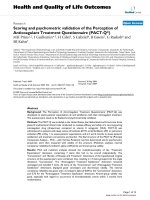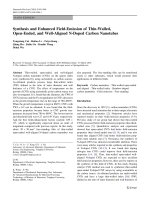Báo cáo hóa học: " Boron and Nitrogen Doped Single walled Carbon Nanotubes as Possible Dilute Magnetic Semiconductors" doc
Bạn đang xem bản rút gọn của tài liệu. Xem và tải ngay bản đầy đủ của tài liệu tại đây (142.47 KB, 3 trang )
NANO EXPRESS
Boron and Nitrogen Doped Single walled Carbon Nanotubes
as Possible Dilute Magnetic Semiconductors
Frank J. Owens
Received: 31 May 2007 / Accepted: 19 July 2007 / Published online: 10 August 2007
Ó to the authors 2007
Abstract The structure of single walled armchair and
zig-zag carbon nanotubes having 70 atoms and two carbons
replaced by boron or nitrogen is obtained at minium energy
using HF/6-31G* molecular orbital theory. The calcula-
tions show that the ground state of the zig-zag tubes is a
triplet state while for the armchair tubes it is a singlet. In
the zig-zag tubes the density of states at the Fermi level is
greater for the spin down states compared to the spin up
state indicating that the doped tubes could be
ferromagnetic.
Keywords Carbon nanotubes Á
Dilute magnetic semiconductors Á Boron Á Nitrogen
Introduction
The switching elements in computers, metal oxide silicon
field effect transistors, involve turning of and on the flow
of current in the form of holes and electrons. On the
other hand the storage of data employs a separate
material consisting of nanosized magnetic materials.
There is considerable interest in combining storage of
information and switching into one material by devel-
oping magnetic semiconductors referred to as dilute
magnetic semiconductors. There have been a number of
reports presenting evidence that semiconductors such as
GaP, GaN, GaAs and ZnO when doped with Cu
2+
and
Mn
2+
are ferromagnetic [1–5]. An alternate approach to
developing magnetic semiconductors might be to explore
the possibility of making single walled carbon nanotubes
(SWNTs) ferromagnetic by appropriate doping of other
atoms for carbon on the walls of the tube. SWNTs can
be viewed as sheets of graphene rolled into tubes which
can be microns in length and have diameters from 5 A
to 20 A. The tubes may be metal, insulating or semi-
conducting depending on their chirality. There is much
interest in developing electronic devices based on
SWNTs and in fact a field effect transistor has been
demonstrate using SWNTs [6]. The tubes may be N or P
doped by substituting nitrogen or boron for carbon in the
walls of the tubes. However there is little experimental
data on the electronic properties of such doped SWNTs.
One particularly interesting report is the observation of
ferromagnetism in nitrogen doped SWNTs opening the
possibility of their use as DMS materials [7]. This result
motivates a further investigation of the electronic and
magnetic properties of boron and nitrogen doped SWNTs
using molecular orbital theory.
There have been a number of theoretical treatments of
carbon nanotubes employing molecular orbital theory
ranging from the semiempirical AM1 method to density
functional theory (DFT) [8–11]. The size of the tube
needed depends on the property that is to be calculated.
The prediction of properties of side wall functionalized
tubes generally requires at least a tube having 70
atoms. On the other hand the properties of tubes func-
tionalized at the open ends can be predicted with much
shorter tubes. To the best of our knowledge there have
been no investigations of the effect of boron and nitro-
gen doping on the electronic or magnetic structure of
SWNTs.
F. J. Owens (&)
Armament Research, Development and Engineering Ctr.,
Picatinny, NJ 07806, USA
e-mail:
F. J. Owens
Department of Physics, Hunter College, CUNY, 959 Park Ave,
New York, NY 10021, USA
123
Nanoscale Res Lett (2007) 2:447–449
DOI 10.1007/s11671-007-9082-4
Methods and Results
The structures at minimum energy of zig-zag (7,0) and
armchair (5,5) tubes are obtained using the Hartree Fock
method employing a 6-31G and 6-31G* basis set. The 6-
31G* is a single point calculation on the optimized 6-31G
structure. This approach rather than a DFT model is used so
as to minimize computer computation time. The calcula-
tions were performed using the Gaussian 03 software
package [12]. Figure 1a shows the optimized structure of a
C
68
B
2
armchair tube and Fig. 1b a zig-zag tube at
minimum energy showing the location of the boron sub-
stitutions. Similar structures are obtained for SWNTs
doped with nitrogen at the same locations as the borons.
Table 1 compares the energy difference between the sin-
glet S = 0 and triplet S = 1 states for both the armchair and
zig-zag tubes. A plus sign indicates that the total energy of
the tube is lower for the triplet state. The results show that
the triplet state has a lower total energy for the zig-zag
tubes but not the armchair tubes. It is noteworthy that the
triplet state is considerably lower than the singlet in the
nitrogen doped carbon nanotubes by 4.23 eV compared to
the boron doped tubes which is only 0.75 eV lower. While
the existence of a triplet ground state in the zig-zag tubes
does not in itself prove that the tubes will be ferromagnetic
it does suggest the possibility. A further evidence for the
possibility of the existence of ferromagnetism in the doped
tubes is that the density of states at the Fermi level is larger
for the spin down state compared to the spin up state. In the
boron doped tubes the density of states of the spin down
state at the Fermi level is 4.28 states/eV compared to 3.62
for the spin up state. Since the boron doped tubes are hole
doped this suggests that carbon nanotubes could be dilute
magnetic semiconductors when incorporated into field
effect transitor devices.
References
1. H. Ohno, Science 281, 951 (1998)
2. P. Sharma et al., Nat. Mater. 2, 673 (2003)
3. I. Zutic, J. Fabian, S. Das, Rev. Mod. Phys. 76, 323 (2004)
4. A. Gupta et al., Phys. Rev. B74, 224449 (2006)
5. B. Seipel et al., J. Mater. Res. 22, 1396 (2007)
6. Ph. Avouris, Acc. Chem. Res. 35, 1026 (2002)
7. S. Suzuki, K. Hidaka, M. Hayashibara, US Patent 6878444B2
(2005)
8. S. Peng, K. Cho, P. Qi, H. Dai, Chem. Phys. Lett. 387, 271 (2004)
9. K. Seo et al., J. Am. Chem. Soc. 127, 15724 (2005)
10. A. Ricca, W. Bauschlicher, Chem. Phys. 323, 511 (2006)
11. S. Santucci et al., J. Chem. Phys. 119, 10904 (2003)
Table 1 Calculated total energy of singlet and triplet state for boron and nitrogen doped single wall zig-zag and armchair carbon nanotubes
Formula Type Method Total energy au (S = 0) Total energy au (S = 1) DE (eV)
C
68
B
2
Armchair HF/6-31G À2622.00653 À2621.97727 À0.080
HF/6-31G* À2622.97134 À2622.94846 À0.623
Zig-zag HF/6-31G À2621.56932 À2621.59915 +0.812
HF/6-31G* À2622.59550 À2622.62336 +0.758
C
68
N
2
Armchair HF/6-31G À2681.40032 À2681.38220 À0.493
HF/6-31G* À2682.42652 À2682.40634 À0.549
Zig-zag HF/6-31G À2681.01968 À2681.18174 +4.410
HF/6-31G* 2682.09264 À2682.24790 +4.230
The last column is the difference in energy between the singlet and doublet states. The + sign means the triplet state has lower energy than the
singlet state
Fig. 1 (a) Optimized structure of C
68
B
2
armchair single walled
carbon nanotube. (b) optimized structure of zig-zag C
68
B
2
single
walled carbon nanotube
448 Nanoscale Res Lett (2007) 2:447–449
123
12. M.J. Frisch, G.W. Trucks, H.B. Schlegel, G.E. Scuseria, M.A.
Robb, J.R. Cheeseman, J.A. Montgomery, Jr., T. Vreven, K.N.
Kudin, J.C. Burant, J.M. Millam, S.S. Iyengar, J. Tomasi, V.
Barone, B. Mennucci, M. Cossi, G. Scalmani, N. Rega, G.A.
Petersson, H. Nakatsuji, M. Hada, M. Ehara, K. Toyota, R.
Fukuda, J. Hasegawa, M. Ishida, T. Nakajima, Y. Honda, O.
Kitao, H. Nakai, M. Klene, X. Li, J.E. Knox, H.P. Hratchian, J.B.
Cross, C. Adamo, J. Jaramillo, R. Gomperts, R.E. Stratmann, O.
Yazyev, A.J. Austin, R. Cammi, C. Pomelli, J.W. Ochterski, P.Y.
Ayala, K.Morokuma, G.A. Voth, P. Salvador, J.J. Dannenberg,
V.G. Zakrzewski, S. Dapprich, A.D. Daniels, M.C. Strain, O.
Farkas, D.K. Malick, A.D. Rabuck, K. Raghavachari, J.B.
Foresman, J.V. Ortiz, Q. Cui, A.G. Baboul, S. Clifford, J. Cio-
slowski, B.B. Stefanov, G. Liu, A. Liashenko, P. Piskorz, I.
Komaromi, R.L. Martin, D.J. Fox, T. Keith, M.A. Al-Laham,
C.Y. Peng, A. Nanayakkara, M. Challacombe, P.M.W. Gill, B.
Johnson, W. Chen, M.W. Wong, C. Gonzalez, J.A. Pople,
Gaussian 03, Revision B.04 (Gaussian, Inc., Pittsburgh PA, 2003)
Nanoscale Res Lett (2007) 2:447–449 449
123









